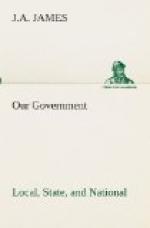How Coins Are Made.—The coinage of money takes place at the mints, which are located at Philadelphia, Denver, New Orleans, and San Francisco. Gold and silver come to the mints in the form of bricks, or rough bars, to which the term bullion is applied. Alloy must be added to the pure metal for the purpose of rendering it of sufficient hardness to withstand wear. In our gold and silver coins one-tenth of the weight is an alloy composed of copper and nickel. A quantity of the bullion of the required purity is first melted and then cast into ingots, or long bars. Each bar is next run between heavy rollers until it takes the form of a thin strip. From the strip are punched round pieces, called “blanks,” of the size and thickness of the coin that is being made. In the next process the blank is weighed on a delicate balance; when found to be of the correct weight, the coin is placed in a powerful press, and from this it comes with its edge raised above the face and its edge milled. In a similar press the designs are stamped upon the faces of the coin.
Below is a list of the coins now being minted.
GOLD Coins.[27]
Double eagle Half-eagle
Eagle Quarter-eagle
SILVER COINS.
Standard dollar Quarter-dollar
Half-dollar Dime
MINOR COINS.
Five-cent (nickel) One-cent (bronze)
The silver coins less in value than one dollar are called subsidiary coins.
[Footnote 27: No gold one-dollar pieces have been coined since 1890.]
The Ratio of Gold and Silver Coins.—The law fixes the weight of pure metal in a silver dollar at 371.25 grains, troy weight, and that of the pure metal in a gold dollar at 23.22 grains. The ratio of these weights is 15.988+: 1, or nearly 16:1. This indicates the origin of the famous expression, “sixteen to one.”
Free Coinage.—By free coinage is meant a policy established by law, under which any person may bring bullion to the mint in any amount and have it coined; that is, the amount which the government will coin is unlimited by law. Our country has always had the policy of free coinage with respect to gold. This was also the policy in the coinage of our silver dollars until 1873. At that time the coinage of the silver dollar was discontinued until a law was passed in 1878 (the Bland Act) renewing its coinage, but in limited quantities. The government purchased silver bullion under this law, and under the Sherman Act (1890), but since 1893 no silver bullion has been purchased for the coinage of silver dollars, but the bullion already on hand has been used for this purpose.
Paper Money.—We have in the United States five kinds of paper money in general circulation:—




